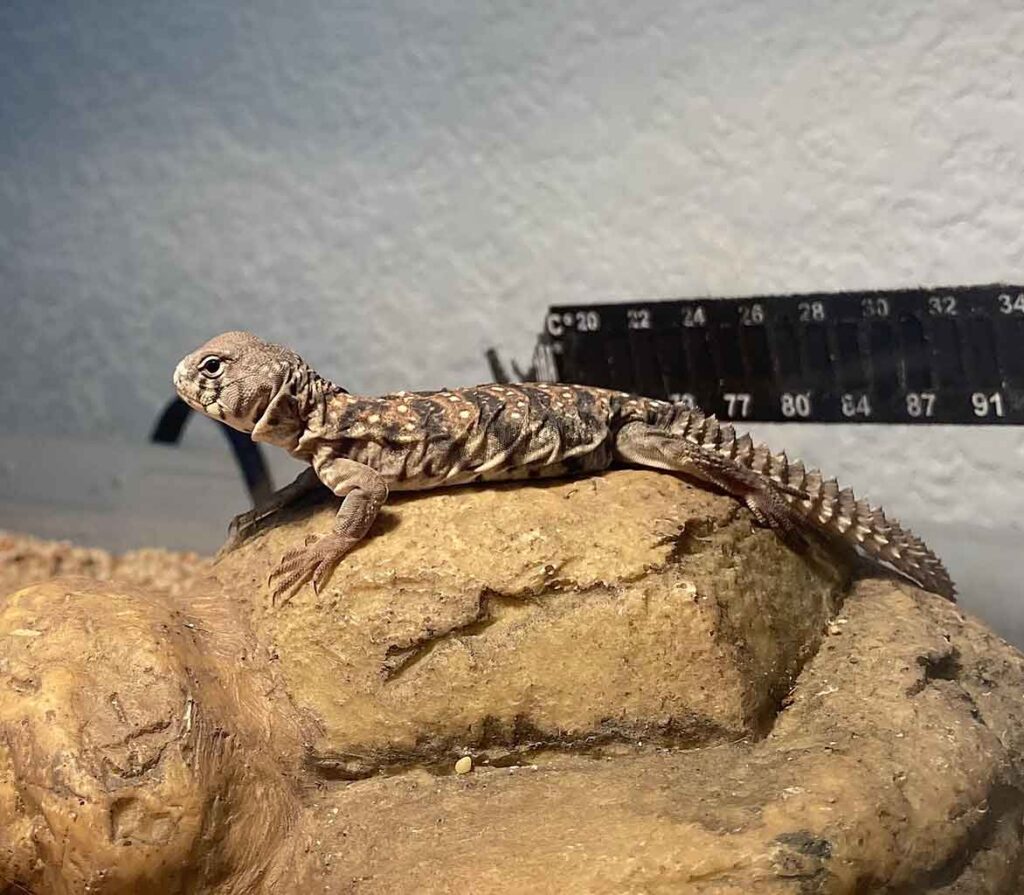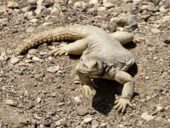
Content |
|---|
The group of Spiny-tailed lizards (Uromastyx) who inhabit the desert comprises near 20 African and Asian species. The Spiny-tailed lizards They have perfectly adapted to their natural habitat and the conditions that prevail there, like heat and drought. Their natural behavior includes the excavation of complex systems of passageways and burrows to which they are removed when necessary..
Among the most popular species are the Ocellated spinytail (Uromastyx ocellata), the Ornate mastigure (Uromastyx ornata), the Egyptian spiny-tailed lizard (Uromastyx aegyptis), the North African mastigure (Uromastyx acanthinura) and Saharan spiny-tailed lizard (Uromastyx geyri). The animals are very demanding to maintain and are not suitable for beginners in terraristics..
All species of Spiny-tailed lizards are subject to species protection legislation. Are subject to registration and proof of origin is required. Buying wild-caught specimens in favor of captive-bred should always be avoided.
Sex differences
Especially in young animals, the sexes are often difficult to distinguish. Sexually mature males usually have distinctive pores on the inside of the thighs, a thickened tail base and, depending on the species, more intense coloration in some parts of the body.
Behavior
The Spiny-tailed lizards show very different levels of intraspecific aggression. Animals can be kept alone or in pairs, in compatible species (for example, the Saharan spiny-tailed lizard – Uromastyx geyri) also in small harems (a male with 2 – 3 females) or groups of females. Animals should be about the same size. Males are usually incompatible with each other. If aggressions occur during socialization, animals must be separated immediately and, as experience has shown, permanently.
The Spiny-tailed lizards are diurnal.
The "Spiny-tailed lizards" in captivity
Terrarium
The minimum dimensions of a terrarium for Spiny-tailed lizards are given in relation to head-torso length (tailless). For each additional lizard, the floor area should be increased by 15 %. For two animals of a medium-sized species such as the Saharan spiny-tailed lizard (Uromastyx geyri), a terrarium of at least 100 x 80 x 60 cm.. But, in the interest of active animals, terrariums should be considerably larger.
Initial team

- Spotlight with UV component and basic lighting
- Spray bottle for terrariums or irrigation system
- Thermometer and hygrometer
- Substrate (mixture of clay and sand)
- Furniture, for example, estate, caves, stones
- Water bowl
- Insects, mineral preparation
Terrarium temperature
Like warm-blooded animals, the Spiny-tailed lizards need a temperature gradient in the terrarium that allows them to reach their optimal body temperature. The ideal is to imitate in the terrarium the natural conditions of the dry regions of Africa and Asia, with areas of bright sun and areas of cooler shade. As such, a powerful heat radiator with UV components is installed on one side of the terrarium, that guarantees strong localized heating at 45 – 50 °C. The other zones should have a temperature of 25 to 30 °C. At night, the temperature of the terrarium should drop slightly for many species.
Terrarium humidity
The humidity should be between the 30 and the 40 %, depending on the species, and may increase slightly at night. This can be achieved by spraying the terrarium with warm water or using a sprinkler system..
Important: In a small area of ​​the terrarium, the substrate should always be slightly moist. Here too wet and collapse-proof burrows should be created. Precise thermometers and hygrometers are needed to measure temperature and humidity.
Terrarium lighting
For proper maintenance of the species, the Spiny-tailed lizards need a lot of light, with a daily lighting period of 12 to 14 hours. At the same time, each animal must have access to resting areas of sufficient size at all times. In addition to a high intensity of light, an adequate supply of UV-A and UV-B radiation must be ensured.
The Spiny-tailed lizards need a lot of ultraviolet light. How light sources emit less and less UV radiation over time (see manufacturer's instructions), must be replaced regularly. Lighting should be placed out of the reach of animals (attention: normal glass is impervious to UV-B rays) or animals must be protected from burns with a closed wire basket.
Terrarium furniture

Stable rock constructions (also imitations), roots and/or branches have proven suitable as furniture. The furniture must be well installed in the terrarium so that the animals can not be harmed by digging underneath, for example. It also, various hiding places (cork tubes, caves) and a shallow bowl of water, in which animals can also bathe, are part of the basic equipment.
A mixture of sand and clay without dust is suitable as a substrate, that you must have at least 20 cm height for small species, so that animals can dig tunnels as they would in nature.
Food
In the wild, the Spiny-tailed lizards feed on plants and animals.
While the proportion of food of animal origin should remain among the 50 and the 80 % for young animals, adult animals should be fed a 80 – 90 % of plant foods and only receive food of animal origin 1 – 2 times a week.
The right foods are the grass of the meadows (for example, dandelion, chickweed), romaine lettuce and very small amounts of zucchini, grated carrots or cucumbers. Fruit should not be offered.
Most lizards readily accept a mixture of seeds (for example, mixtures for exotic or large parakeets). Live insects, like grasshoppers, cockroaches or crickets, sprinkled with a mineral preparation, are suitable as animal feed to prevent deficiency symptoms.
Mealworms should be avoided, the zophobas, wax moths or baby mice for their high fat content. Fresh water must be available at all times.
Attention: the Spiny-tailed lizards tend to become obese.
Care
Food scraps, molts and droppings should be removed daily. The water bowls should also be cleaned daily and filled with fresh water.
Animal health must be monitored daily. The most common health problems in Spiny-tailed lizards are skin mites, lip crust, fatty degeneration and softening of the bones. In case of anomalies, a reptile vet should be consulted. It is recommended to perform fecal examinations once a year to detect endoparasites..
The intestinal flora of Spiny-tailed lizards usually includes salmonella, that are harmless to animals, but they can cause disease in humans. Simple hygiene measures (wash your hands well, etc.) can reliably prevent infection.
Acclimatization and handling
Reptiles are observation animals and company NO. In the first days in his new home, animals need to rest to get used to their new environment.
Animals should only be captured when necessary. The easiest way to do this with young animals is with a pitcher or landing net.. Larger animals can be held with the bare hand behind the head.
- Be careful: the Spiny-tailed lizards can bite hard.
Basically, lizards should never be held or fixed by the tail.
Special features
Depending on its origin, the Spiny-tailed lizards hibernate to a greater or lesser extent in nature, during which they are lethargic and do not usually eat. For selective hibernation, lighting duration can be gradually reduced in autumn until turned off. After 1 or 2 months of actual hibernation, lighting gradually increases again. Before starting hibernation, the health of the animals should be checked by a veterinary fecal examination.
Videos "Spiny-tailed lizards"
|
|
|
|---|
Alternative names:
1. Spiny-tailed lizards, Uromastyces, Mastigures, Dabb lizards (English).
2. Lézards à queue épineuse, Uromastyces, Mastigures, Lézards Dabb (French).
3. Stachelschwanz-Eidechsen, Uromastyces, Mastiguren, Dabb-Eidechsen (German).
4. Lagartos de cauda espinhosa, Uromastyces, Mastigures, Dabb lagartos (Portuguese).
5. Lagartos de cola espinosa, Uromastyces, Mastigures, Lagartos Dabb (español).
List of "Spiny-tailed lizards" for maintenance in captivity
We must make sure that our "Spiny-tailed lizards" have not been caught in their natural environment. There are many protected species, therefore, It is important that the animals that we are going to acquire come from captive breeding.
1 Spiny-tailed lizards
The Spiny-tailed lizards They have perfectly adapted to their natural habitat and the conditions that prevail there, such as heat and... Read more
2 Saharan spiny-tailed lizard
The Saharan spiny-tailed lizard it is a relatively small and slender species for the genus, with an average total length (including the... Read more
3 Ornate mastigure
... Read more
4 Egyptian spiny-tailed lizard
The Egyptian spiny-tailed lizard It is the largest species of Spiny-tailed lizardsEgyptian spiny-tailed lizard –
... Read more
5 North African mastigure
The North African mastigure It is one of the most representative reptiles of the Sahara desert. It is medium in size:... Read more
6 Ocellated spinytail
The Ocellated spinytail is native to northeastern Africa, where it can be found in southern Egypt, Sudan, Eritrea, Djibouti, Ethiopia (near... Read more





